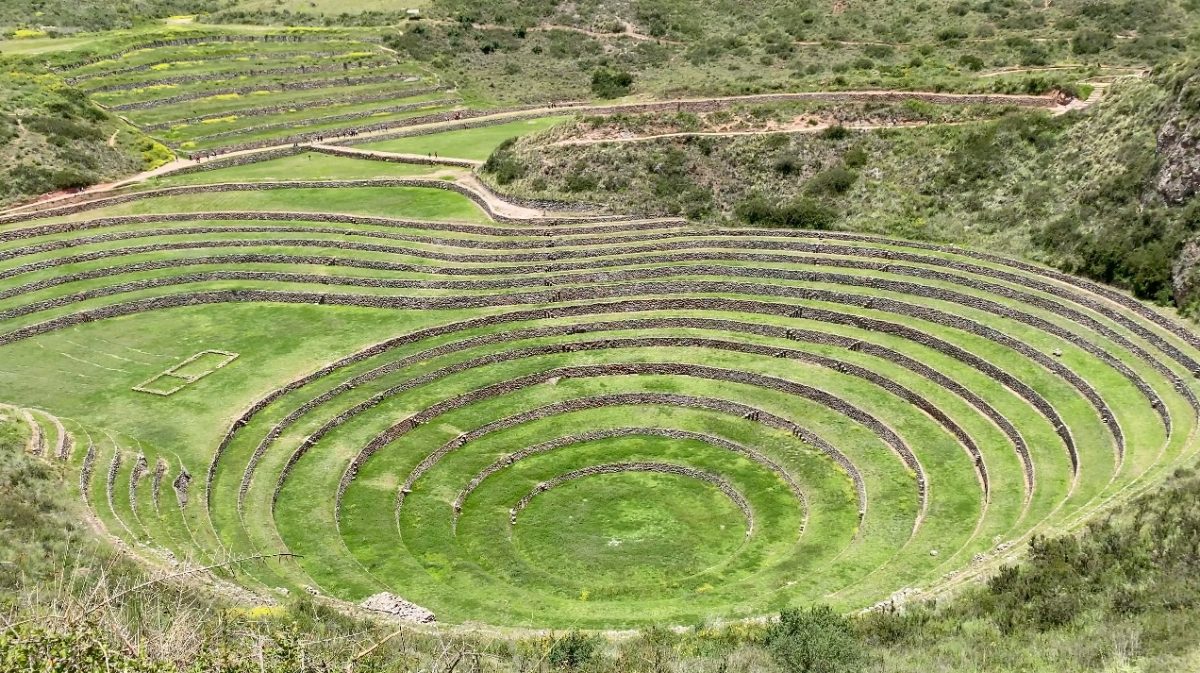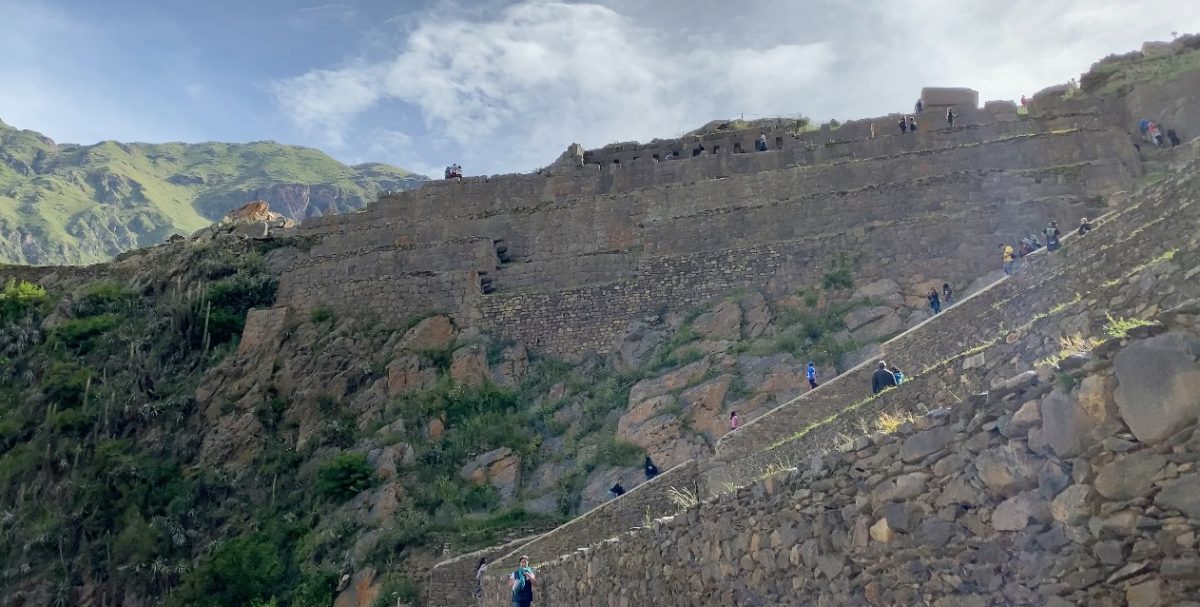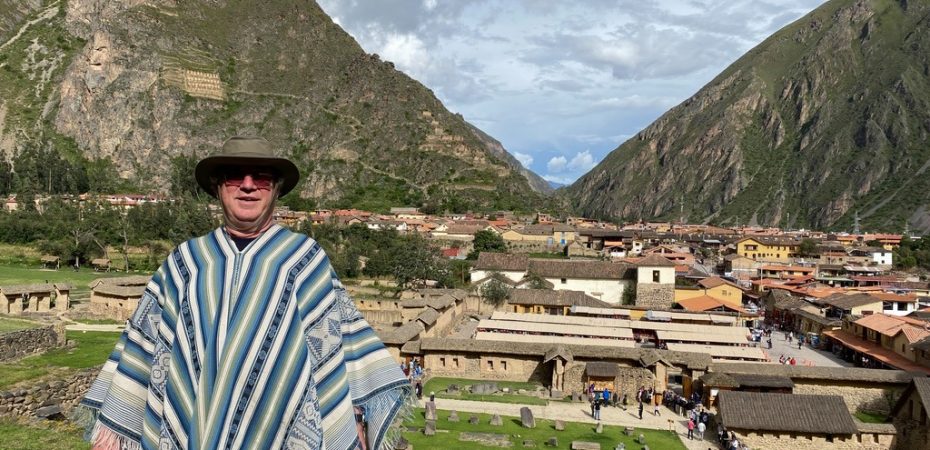Today was one of inspiration and we packed a lot into the day. We visited the Centro de Textiles Tradicionales del Cusco – a community of weavers – women and girls – who make beautiful and sustainable pieces. Next we head to the Moray ruins and the naturally occurring circles. Finishing with the Inca site Ollantaytambo where we visit someone’s house that an Inca family lived in 500 years ago.
Our hotel in Cusco was Casa Andina Premium Valle Sargrado. I was up early, no one else in the courtyard. Sipping coca leaf tea. “To plant a garden is to believe in tomorrow.” Our hotel’s central courtyard is full of plants and flowers. Sitting here in the early morning listening to the birds.

We are staying in the Sacred Valley – home of the Inca Nation.

The bus arrives and we take off to the textile place. Our tour guide hasn’t exactly told us where we are going but says it is not part of the usual tourist tours. Outside he points out the guinea pig food being sold on the street. Later we will meet some guinea pigs.

We arrive at the Centro de Textiles Tradicionales del Cusco – a community of weavers promoting women empowerment. Bought a poncho to support their efforts and have a new outfit when walking the pugs. The shades of blue represent the sea and sky. The yellow is the sun.

The beginners group in the weaving centre. They will spend 8 to 10 years learning to do quality weaving. It is occupied by young girls but anyone can join at this level to learn how to weave.

The kids on are vacation right now so they were busy practising their skills.

This young girl is in the next level. She is 10 and Nilda says she is very gifted.

“The Center for Traditional Textiles of Cusco (CTTC) is a non-profit organization that promotes the empowerment of weavers through the revitalization and sustainable practice of Peruvian ancestral textiles in the Cusco region. This enables the weavers to maintain their identity and textile traditions while improving their quality of life through education and promotion of their textile art.”
The centre was founded by Nilda Callañaupa Alvarez in 1996. Little did she know how big the organization would become and how many women it would help. She led us through a demonstration of what the school does and an explanation on their weaving.


Nilda begins the demonstration by showing a variety of pieces that they have done. It is both a sales pitch but also a moment of pride in the work and idea of the community.

Here she shows the strength of the edging. She explains that mass production is their competition but it can never duplicate the quality of hand made.

A runner for swaddling a baby.

She then brings out samples of the all natural dyes they use. Each colour comes from a different plant. There is also the undyed garments that uses all the colours of the llama.

A bowl of red powder that will be used to dye the wool.

Unrolling the runner from the weaving board.

The advanced level group. It usually takes 8-10 years to get here.

Nilda and her team brought out ponchos for everyone to wear. Selling these products supports the work that the non-profit centre is doing. Each item, like these socks, comes with a picture and the name of the weaver who produced them.

The centre attempted to get into the Guinness Book of records with this giant weaving. However she says it would have cost $14,000 to enter and the money could be better spent elsewhere.

The next surprise from our Peruvian guide was the Moray ruins. Not many tourists go here but our guide surprised us with this site. These concentric circles were natural limestone formations.

Early archeologists suggested it was an amphitheatre or an agricultural research station. It is now believe to be a dedication to Mother Earth. She provided the circles and the Incas embellished them.

On the walk our guide explained the bark of this tree was used as a blood thinner. Because people in high altitudes produce more red blood cells, some have genetically thicker blood.

The stone steps allowing the person to move to the next level.

Back on the bus, headed to the Inca city of Ollantaytambo. Potatoes. Originally cultivated in Peru. Our guide says there are estimated to be about 4,000 different varieties.

We went to this lovely restaurant – Tunupa Valle Sagrado, for a buffet lunch. It had lush gardens all around. Again, another reason for coming to Peru in the rainy season.
Ceviche – the Peruvian national dish. Raw fish in a citrus sauce along with onions or other vegetables. Rice and quinoa sushi.

The original entrace to the Inca trail. There is a new entrance farther up the mountain. The Inca Trail is a 4 day hike to Machu Picchu.

Ollantaytambo. Built by Emperor Pachacuti mid-15th century. The steps to the top where there is a 60 ton square of granite aligned with the sun.

We only climbed to the first level.

Look in the centre and you will see the profile of a face. It is the sun god Viracocha with a beard and a type of crown. On either side are store houses. The wind up there act as a kind of refrigeration.

Fuschiea – the national flower of Peru along with Spanish moss that the Spanish brought.

We did a little walkabout around the town and archeological site. An original Inca door. The design of the trapezoid, with the base being wider at the top.

In front of the door is a water channel bringing fresh, glacial water to your door. Of course, this was 500 years ago. Wouldn’t drink the water today.

A family allowed us to visit their home. They raise Guinea Pigs for food and to sell.

An Inca family lived in this building 500 years ago.

Today the traditions carry on. The skulls of relatives are on display. Day of the Dead is a big celebration in Peru. The guy smoking a cigarrette is a good luck charm. People use to use the Sun God, but the Spanish replaced him with this guy. You hang what you want around his neck – money, minature house, etd. The cigarette is to keep him happy.

